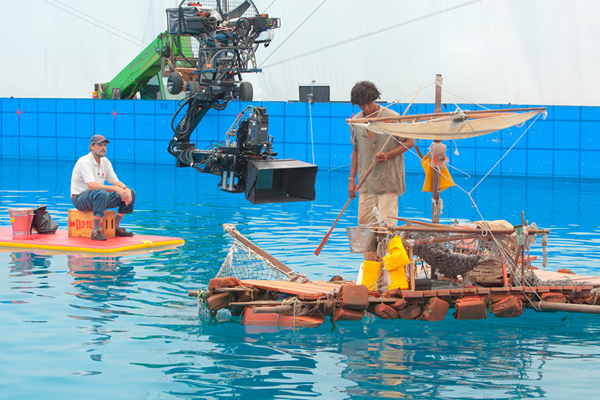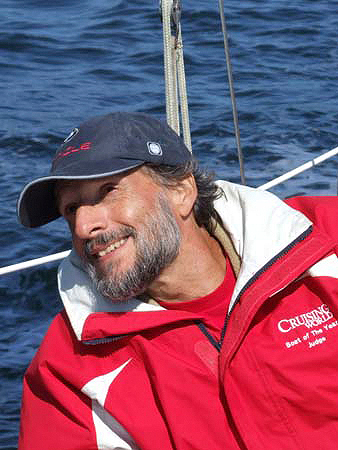LAMOINE — Steven Callahan often says that while others go to church, he goes to sea.
Spending more than two months adrift in a rubber raft – followed by sharks and other menacing creatures – is likely to have a spiritual impact on someone.
And so it did on Callahan, a writer and marine designer living near Ellsworth, who spent 76 days adrift following a shipwreck more than 30 years ago.
It made sense, then, when director Ang Lee tapped Callahan to be the marine consultant for his epic shipwreck film “Life of Pi.”
On Thursday, the film was nominated for a raft full of Oscars, including best picture. The critical acclaim that the nominations signify are particularly rewarding to Callahan because of his very personal connection to the story and with the film.
And because he’s currently facing another life-changing crisis – a battle with leukemia and recovery from a stem-cell transplant in June.
“The film was an exhausting project, but it’s like any project or voyage, being on a raft or having leukemia. You might start out in the wrong direction, you might ask why you’re doing it, but there are always positives to be found,” said Callahan, 60, from his home in Lamoine.
“My wife tells people that my experience was a view of heaven from a seat in hell. There are always negatives existing simultaneously with positives.”
Because of his weakened immune system, Callahan can’t be in large crowds of people or use public transportation, so he’s not sure if he’ll be able to attend the Academy Award ceremonies in Los Angeles Feb. 24.
But he says he already feels rewarded because of how well the film came out, and because moviegoers and critics alike seem to love it.
“I never expected people to be flocking to see it like this, so of course I’m very proud of my involvement,” he said.
Callahan’s own story of survival at sea began in January 1982. The 30-year-old left Spain as part of a solo journey across the Atlantic on a 21-foot-sloop he had built himself, the Napoleon Solo.
Callahan had grown up near Boston sailing out of South Shore towns, and became a self-described “addict” of sailing by his teens. He worked in a variety of marine-related jobs until one day he decided to fulfill a lifelong dream by sailing the Atlantic alone.
“My life was falling apart, I had separated from my wife, so I decided it was the time to do this,” said Callahan, who has since remarried.
A week into the journey, about 450 miles west of the Canary Islands, something hit his sloop, and it sank. Callahan thinks it might have been a whale.
He survived 76 days living a life he describes as that of an “aquatic caveman” on a 6-foot-long raft he named “Rubber Ducky.” He ate barnacles, birds and fish that he speared. He built crude devices to catch rain water he could drink, and was almost done in by sharks and holes in his raft.
Callahan was finally rescued by fishermen who saw the swarm of birds that were following his raft because of the “ecosystem” that had built up on and around the raft during the two months he was adrift.
“Life of Pi” is also about being adrift at sea for weeks. Based on a novel by Yann Martel, it follows the story of a young man, Pi, whose family runs a zoo in India. The family leaves for Canada with some animals on a cargo ship, which sinks. Pi is cast adrift on a small boat with a tiger.
Lee tracked Callahan down to be a consultant on the film largely because of the book Callahan wrote about his shipwreck journey, “Adrift: Seventy-Six Days Lost at Sea.”
Lee and others who worked on the film, including screenwriter David Magee, have praised Callahan’s contributions in several interviews.
“I didn’t see a trace of the traumatic, all I see is the courage,” Lee said of Callahan in a December interview with the Los Angeles Times. “He can make even the most painful experience sound interesting and serene.”
A long-time sailor, Callahan jumped at the chance to work on “Life of Pi” because he’s often disappointed at how other seagoing films come out.
“To me, when I see films set at sea, everything looks flat like it was filmed in a living room, and when they want a storm, they throw buckets of water at the set,” said Callahan. “I was hoping I could help people see the wonder and mystery and beauty of something like this, as well as the dangers and horrors.”
For “Life of Pi,” most of the raft scenes were done in a giant, open-air wave tank built in Taiwan. The waves could be manipulated to create visuals that the director, with input from Callahan, wanted for certain scenes.
In terms of his eye for detail, for instance, Callahan helped the filmmakers understand how the night sky should look and feel to someone who is afloat on a raft hundreds of miles from anywhere.
“There’s a scene in the movie, we call it ‘tiger vision,’ which is later in the movie,” said Callahan. “And I told them there are times, very rarely at night, that the reflection on the water is so disorienting, it’s incredible. It’s like being in outer space.”
Callahan was in Taiwan for about four or five months in 2011 to participate in the filming in a hands-on way. While there, he gave feedback on the script, helped write a survival manual used by the main character, and consulted on everything from boat and raft construction to weather conditions and what nautical things should look like.
He even consulted with Suraj Sharma, the actor playing Pi, on how to realistically drive away sharks with a pole.
“I said, ‘Pick this thing up and hit the shark with it’,” said Callahan with a laugh.
Callahan not only brought his spiritual view of shipwreck survival to the film, he brought years of experience as a sailor, ship designer, and survival and safety consultant. He works out of his Lamoine home and around the world under the company name Steven Callahan and Associates.
Callahan sees some strong similarities between his journey and that of the fictional Pi. While Pi has a tiger as his nemesis and travel companion, Callahan had schools of dolphin fish, not to be confused with dolphins.
The fish followed Callahan’s raft so regularly that he could count on spearing some for food, and he came to count on their company as part of his daily routine and struggle to remain sane.
“I got to know the fish pretty well. They nourished me and were my companions,” said Callahan. “Since I was spearing them and I was in an inflated raft, they almost killed me. But because of the fish, the birds followed me, and that’s what saved me.”
People who know Callahan and have worked with him are not surprised about his involvement in and commitment to “Life of Pi.”
“He has one of the most organized minds of anyone I’ve ever known, and can process information quickly in a remarkably thoughtful and useful way,” said Steve Weiss, a yacht designer from Trenton who has worked with Callahan on various projects.
Besides being nominated for best picture, “Life of Pi” was also nominated in the categories of cinematography, directing, film editing, music, original song, production design, sound editing, visual effects and adapted screenplay.
Callahan is hopeful that his work on the movie might lead to other opportunities to spread his passion for the sea through films.
Although Callahan is not a named Oscar nominee, having such a key role on an Oscar-nominated film is certainly a “feather in his cap,” said Eric Matheson, a former Maine Film Commission member and long-time film production designer based in Maine.
Matheson has worked on several ocean-themed films, including “Message in a Bottle” and “The Perfect Storm.”
“It’s definitely quite an honor to work on a film that gets nominated,” said Matheson.
But Callahan feels he’s already been honored – by the chance to share his passion for the sea with others.
“I feel very personally connected to the film, and the fact that people like it really makes me feel fulfilled,” he said.
Staff Writer Ray Routhier can be contacted at 791-6454 or at:
rrouthier@pressherald.com
Send questions/comments to the editors.




